BERLIN NOT GOAL OF U.S. TROOPS
Forward SHAEF HQ, Reims, France · April 12, 1945
On this date in 1945 President Franklin D. Roosevelt died in Warm Springs, Georgia, and Harry S. Truman became the thirty-third president of the United States. That same day the Supreme Commander of the Allied Expeditionary Force, Gen. Dwight D. Eisenhower, informed his staff that neither American nor British forces would try to capture Berlin, the epicenter of Adolf Hitler’s rapidly disappearing Thousand Year Reich. That task would be left to the Red Army, which by now controlled most of Central and Eastern Europe. For Eisenhower it was a purely pragmatic decision, to say nothing of the political decision reached by Roosevelt, British Prime Minister Winston Churchill, and Soviet dictator Joseph Stalin at the Yalta Conference in the Crimea in February 1945, which placed Berlin within the Soviet zone of postwar-occupied Germany. (Berlin would be carved into four occupation zones anyway, one each for the Soviets, Americans, British, and French.)
Some 2.5 million Soviet soldiers in 20 armies, with support from more than 40,000 mortars and field guns and hundreds of multibarreled Katyusha rockets, were roughly 40–50 miles east of the German capital when the Red Army launched its Berlin offensive on April 16, 1945, from its Oder River bridgehead at Kuestrin. U.S. forces were 120 miles to the west of Berlin. In the wake of the Battle of the Bulge (mid-December 1944 to late-January 1945), the March breach of the Rhine River at numerous points, and the Western Allies’ encirclement of 300,000 troops and 30 generals of Field Marshal Walther Model’s Army Group B in the Ruhr Pocket, it was clear that the Nazis had lost the war, their cause ultimately hopeless. (After dissolving his army and discharging his youngest and oldest members, Model, who took over Field Marshal Erwin Rommel’s old job at Army Group B in August 1944, committed suicide as a matter of honor on April 12, 1945. “What is there left to a commander in defeat,” he had asked his staff before using his service revolver on himself.)
Yet elements of the German Army continued to fight tenaciously on their home turf. “Sieg oder Sibirien” (“Victory or Siberia”) was their battle cry as the Red Army closed in. (Months earlier, in an attempt to stop German soldiers surrendering to the enemy, Nazi propaganda chief Joseph Goebbels had concocted a story that the Western Allies had agreed to hand over German POWs to the Soviets for reconstruction work.) Gen. Omar Bradley, commanding the Twelfth U.S. Army Group, estimated that taking the Nazi capital would cost him 100,000 casualties, while Lt. Gen. William Simpson, commander of the U.S. Ninth Army, part of Bradley’s Twelfth Army Group, supposed his soldiers could have taken Berlin with little loss of life and well before the Red Army had reached the city.
As it turned out the Battle of Berlin (April 16 to May 2, 1945) cost Soviet and Polish troops an estimated 81,000-plus dead or missing and over 280,000 wounded or sick. The blood price paid by the 1.1 million Soviets who took part in the capture of Berlin was high because Stalin had ordered two army group commanders—Marshal Georgy Zhukov of the First Belorussian Front and Marshal Ivan Konev of the First Ukrainian Front—to compete in a race to be first to reach the city the Nazis were prepared to defend with special ferocity. Tragically, more civilians died in the Battle of Berlin (125,000 killed or died from suicide) than German defenders (92,000–100,000).
Soviet Assault on Berlin, Mid-April Through Early May 1945
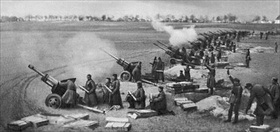 | 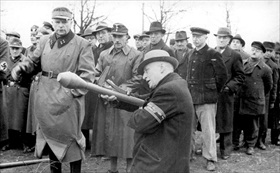 |
Left: Soviet artillery bombarding German positions during the Battle for Seelow Heights, April 16–19, 1945. The battle to break through the so-called “Gates to Berlin,” just over 50 miles/80 km east of the German capital, cost the Soviets about 30,000 casualties, 18,000 more than the Germans lost.
![]()
Right: Ranged against the Soviets, who were assembling on the edges of Berlin, was a motley crew of boys and elderly men comprising the Volkssturm (home guard). Here soldiers of the Volkssturm are being trained to use the Panzerfaust, a small, disposable preloaded launch tube that fired a high-explosive, antitank warhead. Photo taken March 21, 1945.
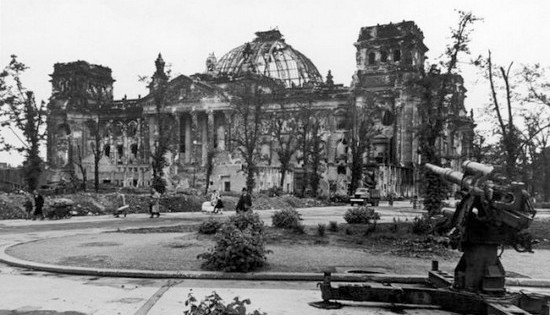 | 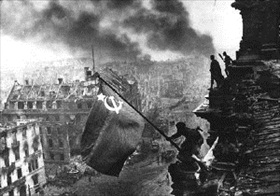 |
Left: The German parliament building, the Reichstag, following its destruction. Photo taken in June 1945.
![]()
Right: “Raising the Red Flag over the Reichstag” is a historic photograph taken on May 2, 1945, during the Battle of Berlin by Red Army photographer Yevgeny Khaldei. This photograph, like that taken by Associated Press photographer Joe Rosenthal of the flag-raising atop Mt. Suribachi on the contested Pacific island of Iwo Jima, came to be regarded as one of the most significant and recognizable images of the war.
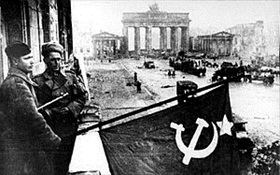 | 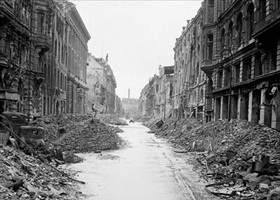 |
Left: Soviet soldiers hoist the Red flag on the balcony of the once prestigious Hotel Adlon on Unter den Linden. Located in the heart of the government quarter, the Adlon was only blocks from Goebbels’ Propaganda Ministry and Hitler’s Reich Chancellery and underground Fuehrerbunker.
![]()
Right: A devastated street in the city center just off Unter den Linden, July 3, 1945. Postwar statisticians calculated that for every inhabitant of Berlin there were nearly thirty-nine cubic yards of rubble. Nearly two-thirds of the rubble was caused by the Red Army, which expended 40,000 tons of explosives in artillery and rocket bombardment in a mere two weeks in April and early May 1945.
Battle of Seelow Heights, April 16–19, 1945
![]()

 History buffs, there is good news! The Daily Chronicles of World War II is now available as an ebook for $4.99 on Amazon.com. Containing a year’s worth of dated entries from this website, the ebook brings the story of this tumultuous era to life in a compelling, authoritative, and succinct manner. Featuring inventive navigation aids, the ebook enables readers to instantly move forward or backward by month and date to different dated entries. Simple and elegant! Click
History buffs, there is good news! The Daily Chronicles of World War II is now available as an ebook for $4.99 on Amazon.com. Containing a year’s worth of dated entries from this website, the ebook brings the story of this tumultuous era to life in a compelling, authoritative, and succinct manner. Featuring inventive navigation aids, the ebook enables readers to instantly move forward or backward by month and date to different dated entries. Simple and elegant! Click 











